WARNING: Graphic photos after the article.
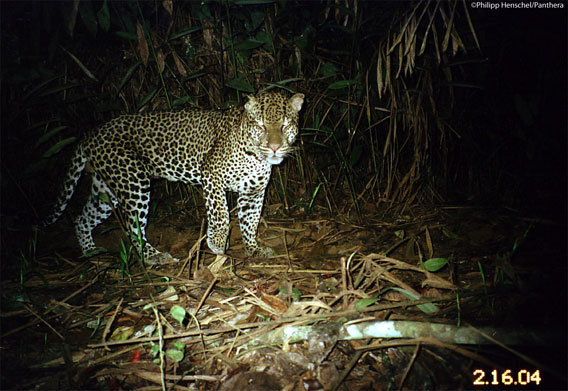
Leopard caught on camera trap in Gabon. Photo by: Philipp Henschel/Panthera.
According to a surprising new study in the Journal of Zoology, bushmeat hunting is imperiling jungle-dwelling leopards (Panthera pardus) in Africa, even though hunters aren’t targeting the elusive big cats themselves. Instead, by hunting many of the leopard’s preferred prey—such as red river hogs and forest antelopes—bushmeat hunters are out-competing leopards.
“Human populations in this region rely primarily on bushmeat for
their protein requirements, and
between one and five million metric tons of wild meat are
estimated to be traded annually,” according to the paper.
In order to determine how leopards are faring in such intensively hunted forests, the study examined leopard presence through camera traps, as well as diet from scat, in and around Ivindo and Lope National Parks in Gabon. In forest areas with high hunting, researchers found that leopards were forced to survive on smaller prey, since most of the larger animals had been hunted out by humans.
“While leopards can hang on in forests with moderate levels of hunting, they are forced to switch their diets to smaller, less preferred prey species and they cannot reach their normal densities. We don’t fully understand the implications of this, but I can imagine this scenario making things very difficult for a female leopard to reproduce—she might be able to keep herself alive but finding a mate and providing for cubs could be hugely challenging,” explains lead author, Philipp Henschel, expert on forest leopards for big cat-NGO Panthera.
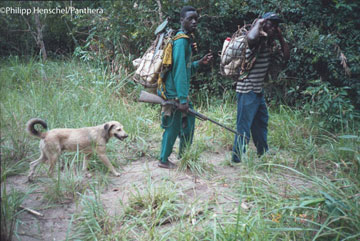 Bushmeat hunting with dog, photo taken by camera trap. Photo by: Philipp Henschel/Panthera. |
Bushmeat hunting can push leopards out altogether, according to the study, which found one site completely absent of leopards even though the site was composed of primary, unfragmented forest and the local people inhabiting the forest have a totem against hunting leopard or eating them.
“[This} is a sobering example of the ‘Empty Forest’ phenomenon. You can have intact, old growth forest that looks basically pristine but is so heavily hunted that there are few large mammals—and no top carnivores at all. It clearly demonstrates the necessity of strictly protected forests where absolutely no bushmeat exploitation occurs,” said Panthera President Luke Hunter, who co-authored the new paper. “Even well-managed logging concessions- those that prohibit their employees from hunting, and actually enforce those rules—can help leopards and their prey. The Congo Basin is one of the most important strongholds for leopards remaining in Africa; it is essential that we find ways to address the massive trade in bushmeat if we want to keep it that way.”
According to the paper, the evidence that bushmeat hunting impacts leopards is likely relevant to other big cats in Africa, Asia, and Latin America.
“Overhunting of prey is undoubtedly a factor affecting
the viability of tiger populations,
and it is also likely a key factor in the ability of jaguars to
persist in human-modified landscapes and move between
them.”
Listed as Near Threatened by the IUCN Red List, leopards have faced many of the same issues that imperil other top predators—poaching, human-wildlife conflict, and habitat loss—but their elusive nature and adaptability have allowed them to hold on better than some of their cat cousins. Of course, this isn’t saying much as leopards have still been pushed out of 40 percent of their historic range in Africa. Three leopard subspecies—the Javan, the Amur, and the Arabian—are listed as Critically Endangered.
CITATION: Henschel, P., Hunter, L. T. B., Coad, L., Abernethy, K. A., & Mühlenberg, M. (2011) Leopard prey choice in the Congo Basin rainforest suggests exploitative competition with human bushmeat hunters. Journal of Zoology, 285, 11-20.
_Laila.568.jpg)
Leopard mother with two cubs (barely visible in the back). Photo by: Laila Bahaa-el-din/Panthera.
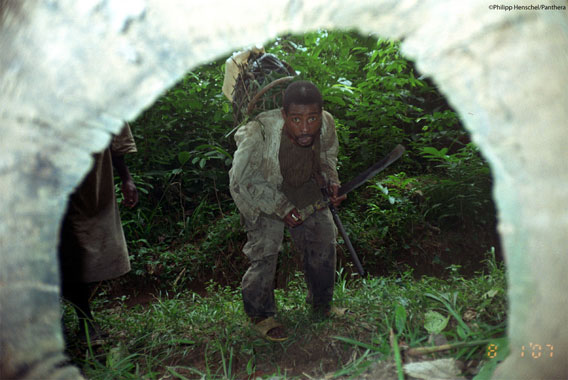
Camera trap hidden in log takes photo of bushmeat hunter. Photo by: Philipp Henschel/Panthera.
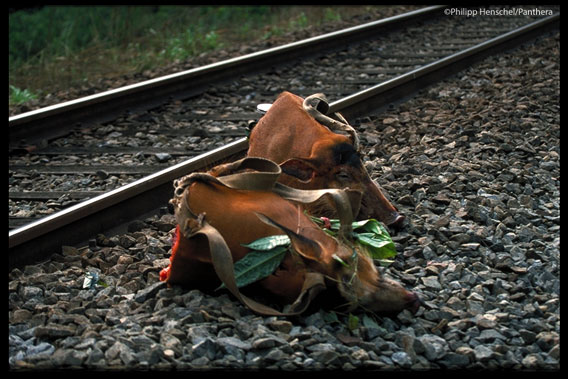
Heads of red river hogs left by train tracks. Red river hogs are preferred prey of both leopards and locals. Photo by: Philipp Henschel/Panthera.
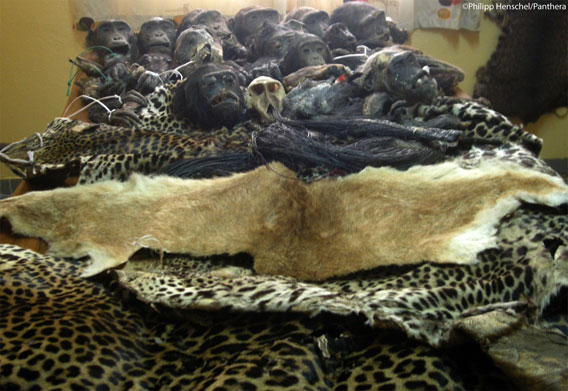
Confiscated animal parts: leopard and lion skins in front, chimpanzee heads in back. Photo by: Philipp Henschel/Panthera.
Related articles
Cameratraps take global snapshot of declining tropical mammals
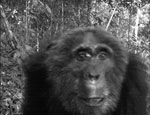
(08/17/2011) A groundbreaking cameratrap study has mapped the abundance, or lack thereof, of tropical mammal populations across seven countries in some of the world’s most important rainforests. Undertaken by The Tropical Ecology Assessment and Monitoring Network (TEAM), the study found that habitat loss was having a critical impact on mammals. The study, which documented 105 mammals (nearly 2 percent of the world’s known mammals) on three continents, also confirmed that mammals fared far better—both in diversity and abundance—in areas with continuous forest versus areas that had been degraded.
China opens trade in ‘legal’ tiger skins
(08/14/2011) The Environmental Investigation Agency (EIA) has warned the US, the UK, and all tiger-range nations that China has re-opened the trade in wild cat skins—including tigers—ahead of a Convention on International Trade in Endangered Species (CITES) meeting this week in Geneva, Switzerland. According to the EIA, China has reinitiated a Skin Registration Scheme that allows the trade of big cat skins from legal sources, such as captive-bred cats and controversial tiger farms, however the NGOS argues the scheme lacks transparency, providing an easy cover for the sale of skins taken from big cats poached in the wild.
Ironic conservation: APP touts tiger relocation after allegedly destroying tiger’s home
(08/02/2011) A female Sumatran tiger (Panthera tigris sumatrae) has been relocated from her threatened rainforest home to Sembilang National Park. According to Asia Pulp and Paper (APP) and the Sumatran Tiger Conservation Foundation (YPHS), the tiger had become an issue in its home region due to human and wildlife conflict. The group touted saving the tiger as ‘a significant moment for Sumatran tiger preservation’. However, Greenpeace says that the tiger would never have been a problem if APP were not destroying its habitat.
Video: Tiger trapped in Asia Pulp and Paper logging concession dies a gruesome death
(07/25/2011) Caught in a snare and left for days without access to food and water, a wild Sumatran tiger (Panthera tigris sumatrae) perished from its wounds hours after forest officers reached it. As reported by Greenpeace—which photographed and filmed the rescue attempt—the tiger was trapped at the edge of a acacia plantation and remaining forest area actively being logged by Asia Pulp and Paper (APP) in Riau Province. Sumatran tigers are listed as Critically Endangered by the IUCN Red List; the subspecies, restricted to the Indonesian island, is in decline due to large-scale habitat loss and poaching.
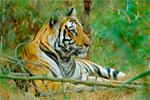
(07/19/2011) We are losing the tiger. Two hundred years ago, Asia’s great cat numbered in the hundreds of thousands and inhabited virtually the entire continent, from Siberia to Turkey, and Afghanistan to Bali. Today there are, at best, around 3,200 wild tigers left. The tiger is extinct in at least 14 countries and hangs on in only 7% of the habitat it once occupied – tiny, mostly isolated fragments in what was once an ocean of forest. Three sub-species, from Bali, Java and Central Asia are lost forever, and a fourth, the South China tiger has not been recorded in the wild for over a decade.
Decline in top predators and megafauna ‘humankind’s most pervasive influence on nature’
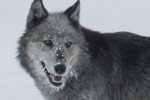
(07/14/2011) Worldwide wolf populations have dropped around 99 percent from historic populations. Lion populations have fallen from 450,000 to 20,000 in 50 years. Three subspecies of tiger went extinct in the 20th Century. Overfishing and finning has cut some shark populations down by 90 percent in just a few decades. Though humpback whales have rebounded since whaling was banned, they are still far from historic numbers. While some humans have mourned such statistics as an aesthetic loss, scientists now say these declines have a far greater impact on humans than just the vanishing of iconic animals. The almost wholesale destruction of top predators—such as sharks, wolves, and big cats—has drastically altered the world’s ecosystems, according to a new review study in Science. Although researchers have long known that the decline of animals at the top of food chain, including big herbivores and omnivores, affects ecosystems through what is known as ‘trophic cascade’, studies over the past few decades are only beginning to reveal the extent to which these animals maintain healthy environments, preserve biodiversity, and improve nature’s productivity.